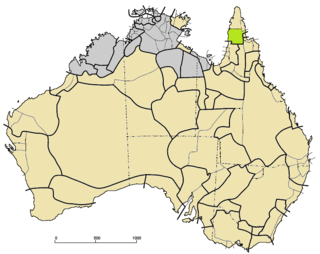Related Research Articles
Wik may refer to:

The Shire of Aurukun is a local government area in Far North Queensland, Australia. The shire covers part of western Cape York Peninsula, the most northerly section of the Australian mainland.
The Yinggarda language is an Australian Aboriginal language. It is an endangered language, but efforts at language revival are being made.

The Wik languages are a subdivision of the Paman languages consisting of sixteen languages, all spoken on the Cape York Peninsula of Queensland, Australia. This grouping was first proposed by R. M. W. Dixon.
Wik-Ngatharr, or Wik-Alken (Wik-Elken), is a Paman language spoken on the Cape York Peninsula of Queensland, Australia, by the Wik-Ngatharr people. It is a co-dialect with Wik-Ngathan, and more distantly related to the other Wik languages. In 1981 there were 86 speakers.
The Wik peoples are an Indigenous Australian group of people from an extensive zone on western Cape York Peninsula in northern Queensland, speaking several different languages. They are from the coastal flood plains bounding the Gulf of Carpentaria lying between Pormpuraaw and Weipa, and inland the forested country drained by the Archer, Kendall and Holroyd rivers. The first ethnographic study of the Wik people was undertaken by the Queensland born anthropologist Ursula McConnel. Her fieldwork focused on groups gathered into the Archer River Mission at what is now known as Aurukun.
Wik-Mungkan, or Wik-Mungknh, is a Paman language spoken on the northern part of Cape York Peninsula of Queensland, Australia, by around 1,000 Wik-Mungkan people, and related peoples including the Wikalkan, Wik-Ngathana, Wikngenchera language groups. Wik Mungkan is healthier than most other languages on the peninsula, and is developing and absorbing other Aboriginal languages very quickly.
Wik-Ngathan, or Wik-Iinjtjenj (Wik-Iinychanya), is a Paman language spoken on the Cape York Peninsula of Queensland, Australia, by the Wik-Ngathan people. It is closely related to the other Wik-Ngathan language, Wik-Ngatharr and more distantly to the other Wik languages. In 1981 there were 130 speakers.
Kugu-Muminh (Wik-Muminh), also known as Kugu- or Wik-Nganhcara (Wikngenchera), is a Paman language spoken on the Cape York Peninsula of Queensland, Australia, by several of the Wik peoples. There are multiple dialects, only two of which are still spoken: Kugu-Muminh itself, and Kugu-Uwanh.

The Paman languages are an Australian language family spoken on Cape York Peninsula, Queensland. First noted by Kenneth Hale, Paman is noteworthy for the profound phonological changes which have affected some of its descendants.
Dhuwal is one of the Yolŋu languages spoken by Aboriginal Australians in the Northern Territory, Australia. Although all Yolŋu languages are mutually intelligible to some extent, Dhuwal represents a distinct dialect continuum of eight separate varieties. In 2019, Djambarrpuyŋu became the first indigenous language to be spoken in an Australian parliament, when Yolŋu man and member of the Northern Territory Legislative Assembly Yingiya Guyula gave a speech in his native tongue.
Marrithiyel, also known as Berringen, is an Australian Aboriginal language spoken by the Marrithiyal people.
Yandruwandha is an Australian Aboriginal language of the Pama–Nyungan family. Yawarawarga is considered a dialect by Dixon (2002), a closely related language by Bowern (2001). It is also known as Yawarrawarrka,Yawarawarka, Yawarawarga, Yawarawarka, Jauraworka, and Jawarawarka).
Mayi-Kulan is an extinct Mayi language formerly spoken on the Cape York Peninsula of Queensland, Australia.
The LINGUIST List is an online resource for the academic field of linguistics. It was founded by Anthony Aristar in early 1990 at the University of Western Australia, and is used as a reference by the National Science Foundation in the United States. Its main and oldest feature is the premoderated electronic mailing list, with subscribers all over the world.
Wik Ompom (Ambama) is an extinct Paman language of the Cape York Peninsula of Queensland, Australia. Its name suggests it is one of the Wik languages, but typologically it is distinct.
The Kugu Nganhcara, also Wikngenchera, Wik-Ngandjara (Ngandjara) are an Australian group of peoples living in the middle western part of the Cape York Peninsula, Queensland in Australia. Today they are primarily concentrated at Aurukan and the Edward river settlement.
The Wikianji were an indigenous Australian tribe of the Cape York Peninsula of northern Queensland.
The Wiknatanja, also spelt Wik Ngathanya, are an Aboriginal Australian people, one of the Wik peoples of the Cape York Peninsula of northern Queensland.
The Wik Epa, also spelt Wikepa, are an Aboriginal Australian people, one of the Wik peoples of the Cape York Peninsula of northern Queensland.
References
- 1 2 Y53 Wik Me'anh at the Australian Indigenous Languages Database, Australian Institute of Aboriginal and Torres Strait Islander Studies (see the info box for additional links)
- ↑ Endangered Languages Project data for Wik-Epa.
- ↑ Endangered Languages Project data for Wik-Keyangan.